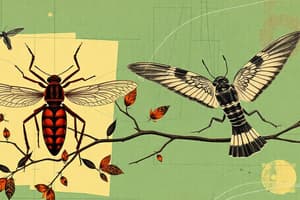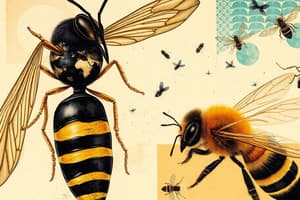Podcast
Questions and Answers
Once the transformation is complete, the butterfly emerges from the ______.
Once the transformation is complete, the butterfly emerges from the ______.
chrysalis
Adult butterflies have a relatively short ______, typically lasting only weeks.
Adult butterflies have a relatively short ______, typically lasting only weeks.
lifespan
During their short lives, butterflies will mate and lay ______, ensuring the continuation of their species.
During their short lives, butterflies will mate and lay ______, ensuring the continuation of their species.
eggs
Butterflies lay their eggs on ______, often on specific plants that their caterpillars will consume.
Butterflies lay their eggs on ______, often on specific plants that their caterpillars will consume.
Signup and view all the answers
Caterpillars, the larval stage of butterflies, are voracious ______.
Caterpillars, the larval stage of butterflies, are voracious ______.
Signup and view all the answers
After several weeks or months of feeding, a caterpillar enters its ______ stage.
After several weeks or months of feeding, a caterpillar enters its ______ stage.
Signup and view all the answers
The chrysalis stage lasts for approximately two ______.
The chrysalis stage lasts for approximately two ______.
Signup and view all the answers
Study Notes
Insect Life Cycles and Butterflies: From Leaf to Chrysalis
Insects, like butterflies, spend their lives traversing a fascinating journey that begins as small eggs and ends with winged marvels. This article will guide you through the wondrous transformations of insects, focusing on butterflies and their remarkable life cycle.
Six Leggy Wonders
Insects, including butterflies, have six legs. These tiny creatures are abundant, critical in ecosystems, and intriguing in their life cycles.
Butterflies' Eggs and Hatchlings
Butterflies lay their eggs on leaves, often on specific plants that their caterpillars will consume. When the eggs hatch, the tiny caterpillars emerge, hungry and ready to grow.
Caterpillar Cravings
Caterpillars, the larval stage of butterflies, are voracious eaters. As they munch on leaves, they grow rapidly, shedding their outer shells multiple times as they transform into larger creatures.
Pupating into a Chrysalis
After several weeks or months of feeding, a caterpillar enters its pupal stage. In the case of butterflies, the pupa is referred to as a chrysalis. The chrysalis protects the caterpillar as it undergoes drastic changes, transforming into a beautiful butterfly.
Two-Week Transformation
The chrysalis stage lasts for approximately two weeks. During this time, complex processes occur within the chrysalis, including cellular division, tissue formation, and the development of the butterfly's unique features, such as its wings and eyes.
The Emergence of a Butterfly
Once the transformation is complete, the butterfly emerges from the chrysalis. Its wings are soft and wet, and it must pump fluid into them to harden and become functional. After several hours, the butterfly is ready to spread its wings and begin its adult life.
Butterfly's Short Life Cycle
Adult butterflies have a relatively short lifespan, typically lasting only weeks. During this time, they will mate and lay eggs, ensuring the continuation of their species.
Conclusion
Insects, including butterflies, are fascinating creatures. Their life cycles are complex and multifaceted, demonstrating the intricate interactions between organisms and their environments. Keep an eye out for these marvels of nature next time you're on a hike or even in your own backyard.
Note: This article does not include references or citations but rather highlights information found in readily available, reputable sources.
Studying That Suits You
Use AI to generate personalized quizzes and flashcards to suit your learning preferences.
Description
Explore the captivating world of insect life cycles, with a focus on the enchanting transformation of butterflies from eggs to chrysalis. Learn about the different stages, behaviors, and marvels of these six-legged wonders.




